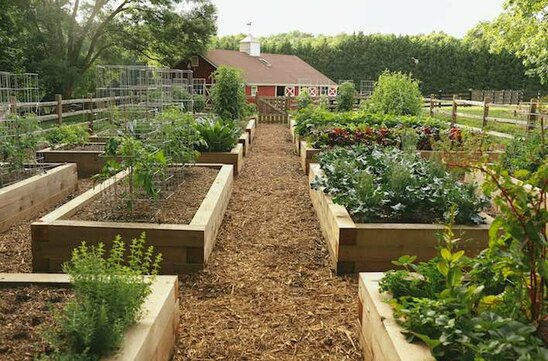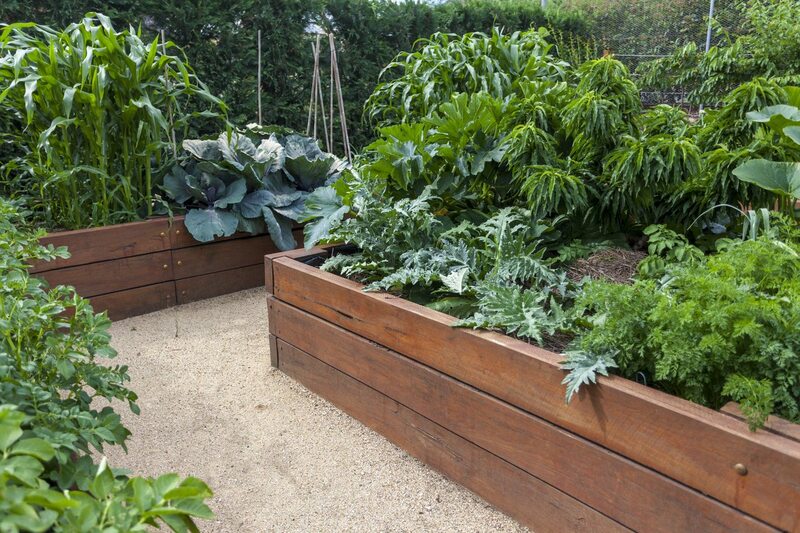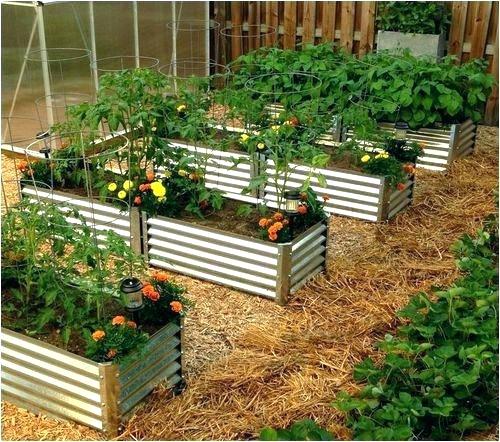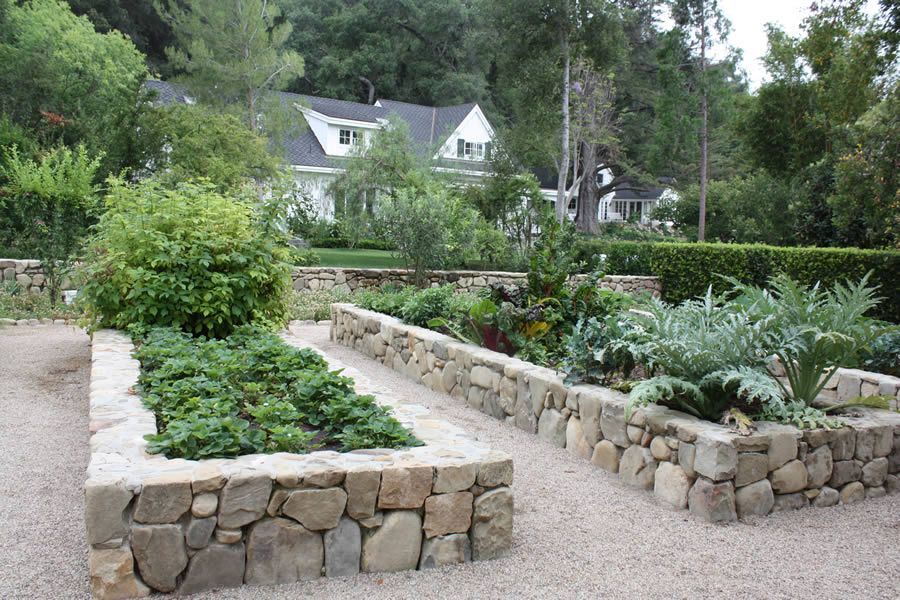Bottom line on top:
- A raised bed is a method of gardening where you raise the level of the soil above ground level
- Raised beds allow roots to grow larger in deeper, looser soil
- Vegetables and flowers grown in raised beds are stronger, healthier, and more productive
What is a "raised bed"?
A raised bed is a method of gardening where you raise the level of the soil above ground level in the areas where you plant. Traditional gardens are planted in narrow rows with wide paths in-between them while raised beds provide the opportunity to widen or change the shape of the growing area.
Why should I make raised beds in my garden?

Because it will result in you getting double the amount of food out of the same space. Here's why
- More room for your roots to stretch out. If provided with loose, well drained soil a plant's roots will spread as deep and wide as they possibly can. We often think of just the thick primary roots we see when we tear something like a weed out of the ground, but there is a network of nearly invisible secondary roots that can spread further and wider than you might think. By giving your plants deeper soil, it allows the roots to grow bigger, which allows them to take in more water and nutrients, ultimately resulting in stronger and more productive plants.
- Keeps kids and tipsy friends from stepping on your plants. It's fun to show people around the garden but it can also be pretty stressful if you're constantly looking back to make sure they know what to step around or over the entire time. By having everything planted in raised beds it creates a clear separation between growing spaces and walking spaces.
- More aerated soil. When you walk in the dirt each step you take is compacting the soil under your feet. This makes it difficult for roots to grow and spread as much as they would have in loose aerated soil. By planting in raised beds you are eliminating any potential foot traffic, which also leaves worms undisturbed to dig tunnels that help to loosen the soil and provide channels for roots and water to flow through. Bigger roots, deeper roots, easier access to nutrients all equals more productive plants.
- Maximizes use garden space. If you visualize a traditional garden planted in rows, it ends up being half planted rows and half empty rows in-between for access and room for the plants to grow. With a raised bed, you can double or triple the size of the planting area with just a single row in-between. Let's say your garden is 12' x 12'. If you planted 1' wide rows with a 1' space in-between, you would only have enough space for 6-12'x1' rows, or 72 square feet of growing space. If you however made 3, 3' wide beds with 1.5' walkways in-between, your 3-12'x3' beds would give you 108 square feet of growing space in the same plot of land. (Sorry for all the math Jill)
- Maximizes use of soil. You've gone to all this trouble to add compost and increase the quality of the soil - why waste it in the walkways? Using the same 12' x 12' garden in the last example, a traditional garden would have you spreading the soil over all 144 square feet of that garden. In the raised bed garden you only need to worry about the 108 square feet of growing space. That allows you to take any good soil out of the walkway and pile it onto your beds.
- Less weeding. Because you are providing deep soil for the plant, this allows you to plant them a lot closer together than the instructions on the seed packet might indicate while still allowing sufficient space for root growth. Once the plants fill in they create a canopy that shades out the ground below making it difficult or impossible for weeds to get the amount of sunlight they need.
Sounds good but how do I make them?
This all depends on how much money you want to invest in this project and how permanent you want the raised beds to be. Personally we wanted the least permanent and free so you can try our method if that's what you're looking for. You can see from the pictures down below that you can make beautiful raised beds out of just about any material if that's the road you decide to go down.
Option A: Build them
There is a pretty wide range of possibilities in this category. I've seen people use old bookshelves where they just lay them down on top of the grass and fill them with dirt. You could also hire a carpenter or stone mason to build the garden of your dreams. Whatever you decide to do, just make sure you are using all natural materials. If you just built a new deck, don't use the old planks to make your raised beds. You don't want paint, stain, or pressure treated chemicals seeping into the soil. Untreated cedar planks are a great option if you're going to build it yourself but metal, stone, or logs would all work great too.
Pros:
Cons:
Pros:
- Looks great
- You can build them up to a height where you don't need to bend over to weed or harvest. For someone who is elderly or disabled this could be the difference between being able to garden themselves or not
- Completely separates beds from walkways allowing for pavement, bricks, stone or other materials to be used for walking areas without mixing into the soil
Cons:
- Once they are built it is very difficult to change the shape and/or design of the garden from year to year. May limit the ability to rotate crops
- Can be very expensive depending on materials used
- Makes it difficult to fully turn over soil before/after growing season. If so soil can become compacted over time since worms can only access from below and run into walls on the side
Option B: Dig them out
This is our method of choice. We start by turning over the dirt from last year's beds in the spring and rake that out to something reasonably flat. From there we basically dig out the walkways and pile the dirt onto what will become the new beds. You then rake those piles flat, and once again pile the dirt that falls into the walkways back on top. As you rake it out, you just give the bed a gentle slope and it will keep it's shape. If you make the edges too square it will fall apart on you.
Pros:
Cons:
Pros:
- Allows the flexibility to change the shape and/or design of the garden from year to year. You can easily widen beds, divide larger ones, or rotate between horizontal and vertical rows every other year,
- It's free. Just requires a shovel, rake and your muscles.
- Makes it easy to fully turn over soil before/after growing season.
Cons:
- Looks a bit more like a graveyard than the White House Rose Garden
- You are limited in how high you can build them up
- Soil from beds and walkways gets mixed together limiting the ability to use pavement, bricks, stone or other materials for walking areas
How big do I make them?
Length: Doesn't really matter. Whatever you have space for
Height: The higher, the better. We've already covered why you want deep soil for your plants. Obviously there becomes a point where it's overkill but if you bring them up to a point where you don't have to bend over too far to reach the dirt you will be a lot more likely to keep up with weeding, pruning, and harvesting. Our raised beds have a height of approximately 8-10 inches high.
Width: We have landed on 3' as the ideal width. If it's a bed you can access from both sides you can easily reach the middle and it's wide enough to plant 2-3 staggered rows depending on what you're planting. Any wider and you might have trouble getting to the middle without stepping on the dirt. If it's up against the fence or contains a trellis where something like peas is going to grow straight up, 2 feet wide is plenty.
Height: The higher, the better. We've already covered why you want deep soil for your plants. Obviously there becomes a point where it's overkill but if you bring them up to a point where you don't have to bend over too far to reach the dirt you will be a lot more likely to keep up with weeding, pruning, and harvesting. Our raised beds have a height of approximately 8-10 inches high.
Width: We have landed on 3' as the ideal width. If it's a bed you can access from both sides you can easily reach the middle and it's wide enough to plant 2-3 staggered rows depending on what you're planting. Any wider and you might have trouble getting to the middle without stepping on the dirt. If it's up against the fence or contains a trellis where something like peas is going to grow straight up, 2 feet wide is plenty.
Tips and Tricks
- Don't create dead ends. Unless your bed is up against the fence/perimeter of your garden, you should be able to walk all the way around it. Otherwise you will neglect the hard to reach corners and it just disrupts the overall flow of the garden
- Mulch or pave the walkways. It's already enough of a job to keep up with weeding the beds, you don't want to spend time weeding the walkways too. Bricks, stone, wood chips, hay, straw, grass clippings, leaves - whatever it is, just make sure it's natural and thick enough to kill any weeds underneath
- Don't do the maze of raised beds in the grass. Yes - this looks adorable on Pintrest. And you'll hate every second of having to weed-whack in between them once a week. Dig out that grass and toss it in the compost. Take any good dirt for your beds and then cover the walkways with some other organic material
The 4 Keys To Gardening Success
Raised Beds are one of our 4 keys to organic gardening success. Check out the rest of the series:


